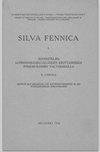Life form dynamics of the tree layer in evergreen and deciduous broad-leaved mixed forest during 1996–2017 in Tianmu Mountains, eastern China
IF 1.7
3区 农林科学
Q2 FORESTRY
引用次数: 1
Abstract
In the forest areas of eastern China, there is a change from forest dominated by deciduous broad-leaved trees to forest dominated by evergreen broad-leaved trees as the latitude or altitude decreases. Different life forms have different survival strategies to deal with climate change, and studying the life form dynamics of the tree layers in the mixed forest in eastern China, with increasing temperature, can help us understand how the forest responds. This study was performed in a 1 ha plot in evergreen and deciduous broad-leaved mixed forest in Tianmu Mountain National Nature Reserve. Based on the data from two surveys (1996 and 2017), the changes in life form composition and biodiversity over the past 21 years were analyzed. We obtained the following results: (1) The proportion of evergreen trees increased from 55.0% in 1996 to 67.5% in 2017, and the dominance of evergreen species was enhanced. (2) The diversity of both life forms increased, and the tree species were more abundant. (3) The average annual recruitment rate of the evergreen species was 2.1% greater than their mortality rate, and the average annual recruitment rate of the deciduous species was 0.5% less than their mortality rate. (4) The competition among the trees in the small-diameter class (10 cm ≤ DBH < 20 cm) was fierce for many tree species. The proportion of the evergreen species in the small-diameter class was high. The life forms making up the mixed climax forest community has changed over the past 21 years, with the proportion and dominance of evergreen trees increasing significantly.1996-2017年天目山常绿落叶阔叶混交林乔木层生命形态动态
在中国东部林区,随着纬度或海拔的降低,森林由落叶阔叶林为主向常绿阔叶林为主转变。不同的生命形式有不同的生存策略来应对气候变化,研究中国东部混交林树木层的生命形式动态,随着温度的升高,可以帮助我们了解森林如何应对气候变化。本研究在天目山国家级自然保护区常绿落叶阔叶混交林1 ha样地进行。基于1996年和2017年两次调查的数据,分析了近21年来生命形式组成和生物多样性的变化。结果表明:(1)常绿乔木占比从1996年的55.0%增加到2017年的67.5%,常绿树种优势度增强;(2)两种生命形式的多样性增加,树种更加丰富。(3)常绿树种的年平均吸收率比其死亡率高2.1%,落叶树种的年平均吸收率比其死亡率低0.5%。(4)小径级(10 cm≤胸径< 20 cm)树种间的竞争较为激烈。小径类常绿树种所占比例较高。在过去的21年中,混交林顶极林群落的生命形式发生了变化,常绿乔木的比例和优势度显著增加。
本文章由计算机程序翻译,如有差异,请以英文原文为准。
求助全文
约1分钟内获得全文
求助全文
来源期刊

Silva Fennica
农林科学-林学
CiteScore
3.50
自引率
11.10%
发文量
21
审稿时长
3 months
期刊介绍:
Silva Fennica publishes significant new knowledge on forest sciences. The scope covers research on forestry and forest ecosystems. Silva Fennica aims to increase understanding on forest ecosystems, and sustainable use and conservation of forest resources. Use of forest resources includes all aspects of forestry containing biomass-based and non-timber products, economic and social factors etc.
 求助内容:
求助内容: 应助结果提醒方式:
应助结果提醒方式:


